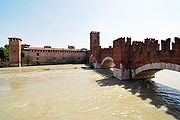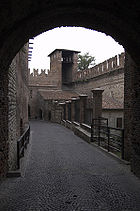
Castelvecchio (Verona)
Encyclopedia

Castle
A castle is a type of fortified structure built in Europe and the Middle East during the Middle Ages by European nobility. Scholars debate the scope of the word castle, but usually consider it to be the private fortified residence of a lord or noble...
in Verona
Verona
Verona ; German Bern, Dietrichsbern or Welschbern) is a city in the Veneto, northern Italy, with approx. 265,000 inhabitants and one of the seven chef-lieus of the region. It is the second largest city municipality in the region and the third of North-Eastern Italy. The metropolitan area of Verona...
, northern Italy
Italy
Italy , officially the Italian Republic languages]] under the European Charter for Regional or Minority Languages. In each of these, Italy's official name is as follows:;;;;;;;;), is a unitary parliamentary republic in South-Central Europe. To the north it borders France, Switzerland, Austria and...
. It is the most important military construction of the Scaliger
Scaliger
The noble family of the Scaliger were Lords of Verona. When Ezzelino III was elected podestà of the commune in 1226, he was able to convert the office into a permanent lordship...
dynasty that ruled the city in the Middle Ages
Middle Ages
The Middle Ages is a periodization of European history from the 5th century to the 15th century. The Middle Ages follows the fall of the Western Roman Empire in 476 and precedes the Early Modern Era. It is the middle period of a three-period division of Western history: Classic, Medieval and Modern...
.
The castle is powerful and compact in its size with very little decoration - one square compound built in red bricks, one of the most prominent examples of Gothic architecture
Gothic architecture
Gothic architecture is a style of architecture that flourished during the high and late medieval period. It evolved from Romanesque architecture and was succeeded by Renaissance architecture....
of the age, with imposing M-shaped merlons running along the castle and bridge walls. It has seven towers, a superelevated keep
Keep
A keep is a type of fortified tower built within castles during the Middle Ages by European nobility. Scholars have debated the scope of the word keep, but usually consider it to refer to large towers in castles that were fortified residences, used as a refuge of last resort should the rest of the...
(maschio) with four main buildings inside. The castle is surrounded by a ditch, now dry, which was once filled with waters from the nearby Adige
Adige
The Adige is a river with its source in the Alpine province of South Tyrol near the Italian border with Austria and Switzerland. At in length, it is the second longest river in Italy, after the River Po with ....
.
Castelvecchio is now home to the Castelvecchio Museum and the local officer's club which can be accessed through the left door on Via Cavour.
History

Ancient Rome
Ancient Rome was a thriving civilization that grew on the Italian Peninsula as early as the 8th century BC. Located along the Mediterranean Sea and centered on the city of Rome, it expanded to one of the largest empires in the ancient world....
fortress outside the Roman city. Lord Cangrande II della Scala
Cangrande II della Scala
Cangrande II della Scala was Lord of Verona from 1351 until his death.In 1351, after the death of his father Mastino II della Scala, he inherited the lordship of Verona and Vicenza, initially under the regency of his uncle Antonio...
had it built along with its bridge
Castelvecchio Bridge
The Castelvecchio Bridge or Scaliger Bridge is a fortified bridge in Verona, northern Italy, over the Adige River...
across the Adige River as a deterrent to his powerful neighbors such as Venice, the Gonzaga
House of Gonzaga
The Gonzaga family ruled Mantua in Northern Italy from 1328 to 1708.-History:In 1433, Gianfrancesco I assumed the title of Marquis of Mantua, and in 1530 Federico II received the title of Duke of Mantua. In 1531, the family acquired the Duchy of Monferrato through marriage...
and the Sforza families. Construction was carried out between 1354 and 1376 (Cangrande died in 1359). The fortified bridge was intended to allow the seigniors to escape safely northwards to the Tyrol in the event of a rebellion or a coup d'état (the Scaligeri were allies of the Holy Roman Empire
Holy Roman Empire
The Holy Roman Empire was a realm that existed from 962 to 1806 in Central Europe.It was ruled by the Holy Roman Emperor. Its character changed during the Middle Ages and the Early Modern period, when the power of the emperor gradually weakened in favour of the princes...
) and when they eventually lost their hold on Verona, its surviving members left Italy to found a German branch of the family.
Later, during the Venetian domination
Republic of Venice
The Republic of Venice or Venetian Republic was a state originating from the city of Venice in Northeastern Italy. It existed for over a millennium, from the late 7th century until 1797. It was formally known as the Most Serene Republic of Venice and is often referred to as La Serenissima, in...
, slits were added to defend it with cannons. The castle was damaged by French troops during the Napoleonic Wars
Napoleonic Wars
The Napoleonic Wars were a series of wars declared against Napoleon's French Empire by opposing coalitions that ran from 1803 to 1815. As a continuation of the wars sparked by the French Revolution of 1789, they revolutionised European armies and played out on an unprecedented scale, mainly due to...
(1796-7), in retaliation to the Pasque Veronesi, when the local population staged a violent anti-French revolt. Napoleon had chosen to stay in Castelvecchio on his trips to Verona, but his widespread and arbitrary requisitions of citizens' and churches' property, the massive draft of male workers into the French army prompted the resistance that eventually drove out the invaders.
Under the Austria
Austria
Austria , officially the Republic of Austria , is a landlocked country of roughly 8.4 million people in Central Europe. It is bordered by the Czech Republic and Germany to the north, Slovakia and Hungary to the east, Slovenia and Italy to the south, and Switzerland and Liechtenstein to the...
ns, Castelvecchio was turned into barracks.
In 1923 the castle was restored, as well as in 1963-1965.
See also
- History of VeronaHistory of Verona-Pre-Roman Verona:The origins of Verona are unclear.*According to some theories it was a city of the Euganei, who were obliged to cede the city to the Cenomani circa 550 BC....
- ScaligerScaligerThe noble family of the Scaliger were Lords of Verona. When Ezzelino III was elected podestà of the commune in 1226, he was able to convert the office into a permanent lordship...
- Castelvecchio BridgeCastelvecchio BridgeThe Castelvecchio Bridge or Scaliger Bridge is a fortified bridge in Verona, northern Italy, over the Adige River...

